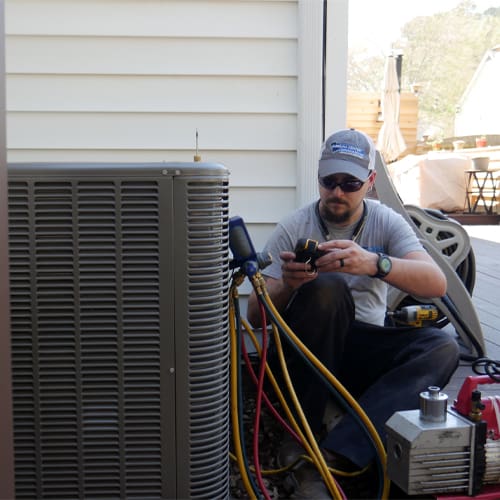AC Evaporator Coils: Frequently Asked Questions
What’s an AC coil and why does it matter?
We should start by telling you what an AC coil is. But first, you need to know how your AC system works – we’ll keep this short, don’t worry.
Overview of your AC system
Your AC will blow cold air out of the vents in your home, but that air starts out pretty warm before it gets there. Your HVAC system will suck in warm air from inside your home, do a little science to it, then blow cold air back out of your vents into your home. That “science” part in the middle is where the AC evaporator coil comes in.
Explaining the evaporator
The evaporator coil itself is located exactly where you would guess, in the evaporator. But what is the evaporator? It is the part that absorbs heat and removes it from your air. This is all thanks to a special thing called “refrigerant”. It does a great job of absorbing a lot of heat as hot air passes over it.

The other special thing about refrigerant is how easy it is to transition from a liquid to a gas. When you boil a pot of water, you’re turning liquid water into a gas. When you get it above 212 degrees F, also known as water’s boiling point, the water starts to turn into a gas.
Refrigerants have a much lower boiling point. Typical refrigerant can boil around -55 degrees F. The reason it can be a liquid at all is because your HVAC system puts it in the right conditions – a big part is applying pressure to the gas. Going from a liquid to a gas and back is a huge part of your HVAC system.
Why does refrigerant need to go from liquid to gas?
So, let’s think about the process again: hot air comes in, refrigerant absorbs heat from the air, the refrigerant heats up and becomes vapor (or gas to most of us), cold air comes out. By cycling out the hotter refrigerant vapor, you can pump in cooler refrigerant liquid. Since your HVAC system is a closed loop, that means that you can’t really add or subtract refrigerant easily. The same bunch of refrigerant keeps going around the loop, from vapor to liquid and back to vapor again.
Liquid refrigerant is great at absorbing a lot of heat, and vapor refrigerant is great at giving off heat. One way to think about it is the refrigerant is just taking the heat from your air and dumping it somewhere else. We never mentioned where this refrigerant is stored, though. It’s held in your evaporator coils.
What about the evaporator coil?
Some HVAC genius back in the day realized that if the hot air has more exposure to the refrigerant, the resulting air will be even colder.
That man’s name must have been Jimmy Evaporator Coil because that’s what the final product became – an evaporator coil. If you curl the tubes into a bunch of U-bends, you get what’s called a coil. A single tube will get bent multiple times before you have a single evaporator coil.
Then you add some “fins” to the mix. Fins are long, thin pieces of metal. These fins help give the air even more time to mingle with the refrigerant in the coils.
This coil is where all the magic happens. The hot air works its way through a maze of refrigerant in coils and fins, and it comes out a lot cooler on the other end. It continues through your ductwork until it comes out of the vents in your house.
Once the refrigerant in the coil absorbs enough heat from the warm air, it flows away from the coil and goes to another part of your HVAC system to dump the heat. Cooled refrigerant is brought into the coil, ready to absorb heat. This process continues as long as your HVAC system is working right.
What does an evaporator coil look like?
If you do your own wrench-turning on your car, you’ll know what your radiator looks like. An evaporator coil looks just like that.
It comes in two styles:
- A traditional coil which looks the letter A
- A slant/slab coil which is a rectangular piece
Even though the body of the coil is different, the concept is the exact same that you learned earlier. Either configuration will have snaking pieces of tube poking out and worming through the body of the evaporator coil.
If you have copper coils, the color of the coil will be a dead giveaway that you’re looking at the right thing. If you’re looking at the coil, you might see an inlet and outlet sticking out. The coil is probably inside a metal covering, so don’t expect to immediately stumble across it. Now that you know what it looks like, let’s tell you how to troubleshoot a bad evaporator coil.
How do I know if my AC coil is bad?
The bad news is that it’s really hard to know if your coil is the culprit of a broken AC system. There are a few symptoms of a bad evaporator coil that you can look out for:
- Refrigerant leaking out of the system
- Warm air coming out of your vents when the AC is running
- AC is running a lot but your house still feels warm
- Your AC is making a hissing or banging noise
The truth is that you’ll need a pro to diagnose the problem and tell if your AC coil is bad.
If you have any of these problems going on in your home, go ahead and give us a call. We’ll send one of our guys out to take a look. If we think you need a new coil or any other major repairs, we’ll give you a free second opinion to make sure we didn’t miss something on the first inspection. Our senior techs know what to look for. We’ll get you squared away in no time.

When should an evaporator coil be replaced?
Whenever a coil goes bad, it usually means you need to have it replaced. If we find a leak in your evaporator coil, we’ll suggest replacing it 9 times out of 10. In the rare 10th time, we can repair it and fix your system.
Besides a leak or excessive wear in your coil, there’s no reason to replace a perfectly good evaporator coil. Unless you’re upgrading your system, you can just leave it alone. Why do we suggest replacement instead of repair? Replacement is usually a lot cheaper for you. It all comes down to the science behind why your coil is leaking.
What causes a leak in an evaporator coil?
The coils in your evaporator are commonly made of copper. Copper is great because it conducts heat pretty easily, but it also rusts and wears quicker than other metals. One form of rust is called formicary corrosion, and it’s a big issue with evaporator coils. Let’s talk about what this is.
What is formicary corrosion?
This type of rust is specific to copper tubes and coils. It is essentially a ton of little pinholes that rust through the walls of your copper coil. You probably can’t see them with the naked eye, but it will ruin your coils.
Formicary corrosion starts with a nasty cocktail: water, oxygen, and a form of organic acid. All three ingredients need to be present in order to make formicary corrosion. Wait a second, acids are flowing through your AC unit? Not quite.
Where do the organic acids come from?
The organic acids are actually coming from what’s called volatile organic compounds (just call them VOCs). VOCs can be found in paint, adhesives, plywood, tobacco, spray foam insulation, and cleaning products – many of which you probably have all over your home.
Since VOCs are air-based, they can creep anywhere they want to. This means in your home, in your attic, in your HVAC system, and in your evaporator. Water and air are naturally present around your evaporator coil. This means all three ingredients are present, so the result is formicary corrosion. This is the leading reason why your coil is leaking.
How does formicary corrosion cause a leak?
As mentioned a second ago, formicary corrosion is made up of tiny little pinholes. This causes two things: refrigerant leak, and pressure leak. If you poke pinholes in a balloon, it will deflate – same idea here.
An AC coil only works when refrigerant is present and pressurized. Formicary corrosion ruins both of these characteristics. The longer you’ve had your coils, the more likely they are to fail.

Is there a way to make an evaporator coil last longer?
Every time we replace a coil, the homeowner is in shock. It’s hard to believe that a coil that’s either in your attic, behind paneling, or in an AC unit can somehow rust and break. Sadly, this is just what happens in your AC system thanks to the VOCs floating around.
VOCs aren’t the only thing that can damage your coils. Outside of formicary corrosion, things like dirt and failures elsewhere in your HVAC system can cause your coil to break.
If you want to make the coils last longer, you need to get regular HVAC maintenance from a trusted, professional company. Since we’re talking about maintenance, let’s talk about cleaning your coils.
Can you clean your AC coils yourself?
You can definitely try to clean the coils on your own, but there are some problems. First of all, you have to know what you’re looking for. Your AC system doesn’t come with a map of what the different parts are and where to find them.
You know what an evaporator coil looks like, but not where it is. Depending on your system, the coil can be hidden in a few different places: up in your attic, in a special cabinet, in a crawl space, or inside your AC unit.
Once you find the coil, grab a flashlight and look at how dirty it is. If you feel brave, use a non-corrosive cleaner with a soft towel and wipe down the coil. Keep in mind, you won’t be able to clean off any formicary corrosion. In fact, you won’t even be able to see if it’s there.
If you want the best results, you should have one of our guys help you. We’ve done it a million times during our 30 years in business, and all of our trucks are equipped with cleaning products made specifically for your evaporator coil. Still, a quick cleaning is a good way to keep your coils going. Once you find your coil, cleaning is a low-effort way to save a lot of money.
How much should it cost to replace an evaporator coil?
Speaking of cost, how much will it cost to replace your coil? If you’ve got a manufacturer’s warranty, you can expect to pay between $600 and $1,200 for a full replacement. This cost is usually for the labor and refrigerant, which isn’t covered under the warranty. Without this warranty, you can expect to pay more.
Can evaporator coil leak be fixed?
That’s a tricky question. It really depends on what part of the coil has the leak and how bad the leak is. Finding the leaking part of the coil is the first bit of trouble. It’s like finding a needle in a haystack. If the leak is on the outer u-bends of the coil, we might be able to repair it. We’d have to drain out the refrigerant, take off the section, and carefully put on a new section of copper coil.
If it’s on the inside of the coil within the metal housing, it’s near impossible to repair it. The worst part is that there can be multiple places where your coil is leaking. We can go through that whole process to fix one leak and find out there’s still another leak hiding elsewhere. That’s why we typically recommend replacement. In a lot of cases, it’s cheaper for you if we put in a brand-new coil.
I still have questions about my AC evaporator coil
Still have questions? Not a problem. Let our team help you and answer any questions you might have. We’re always just a phone call away – Carolina Comfort is here to help. We can swing by your house and take a look at your AC system.

5636 Bush River Rd.
Columbia, SC 29212
SC License – #M104545
NC License – #32356
Phone: (803) 794-5526

